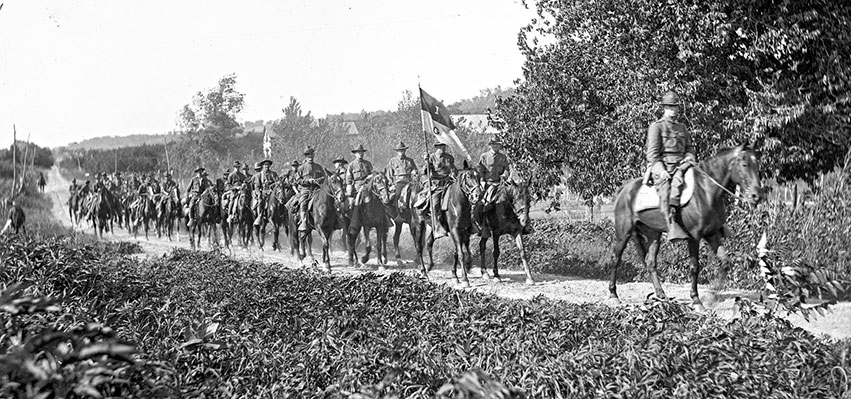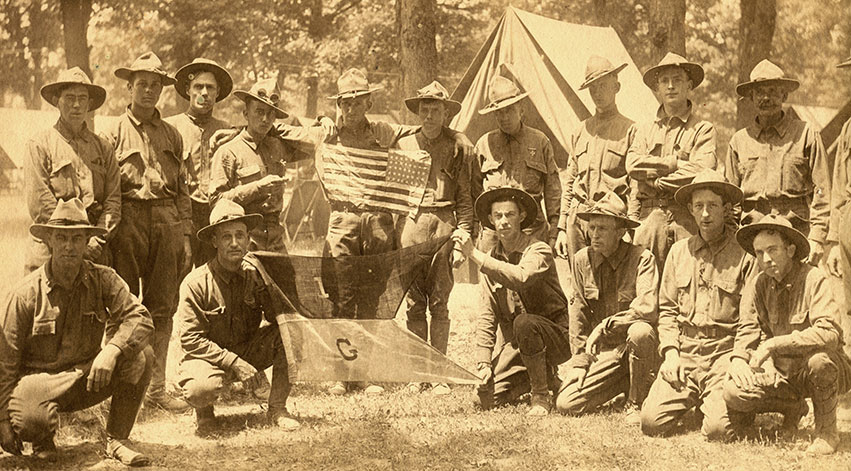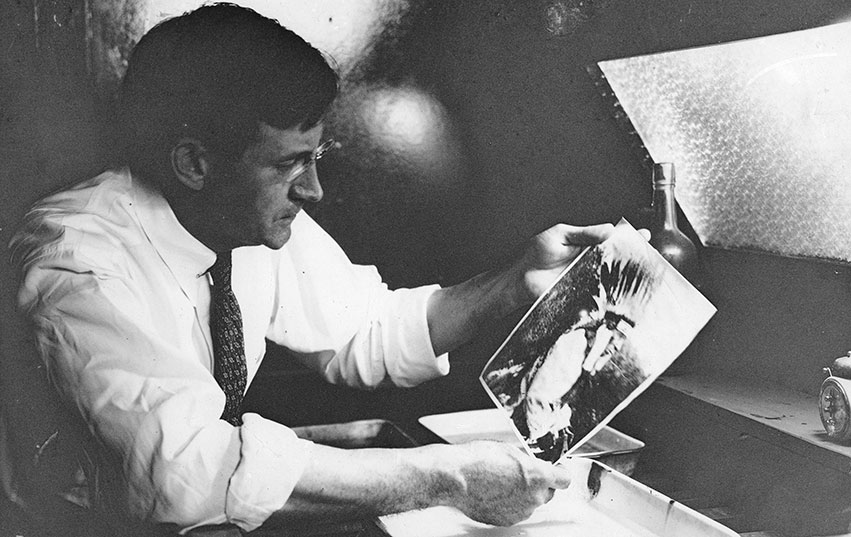Dallas R. Sweney served his country during wartime and his community during peacetime.
He was one of the boys from Peoria who volunteered to fight during World War I—serving in Battery C of the 124th Field Artillery, 33rd Division (formerly Troop G of the Illinois First Cavalry). But Dallas R. Sweney wasn’t just any boy, he was our boy. The Peoria Public Library’s, that is.
Overseas from Peoria
Dallas Sweney lived at 807 Spring Street in Peoria all his life. Born in 1883, he was first employed by the Peoria Public Library at the age of 18 upon graduating high school. In May of 1917—just weeks after the United States entered the Great War—Dallas, 34 years of age, volunteered for service with the Illinois First Cavalry in Peoria. Board meeting minutes show that Peoria Public Library’s board of directors unanimously agreed to extend Dallas a leave of absence from his position at the library.

Dallas, or “Dal” as he was known, trained as a cavalryman with the Illinois First Cavalry Troop G after his enlistment. Just a few weeks later, Troop G became Battery C of the 124th Field Artillery. Battery C traveled to Camp Lowden in Springfield, Illinois, in August 1917 and then to Camp Logan in Houston, Texas, in September for further training. The 124th left for France in May of 1918 and first entered battle in September of the same year, participating in the Meuse-Argonne Offensive—the largest offensive in U.S. military history, with more than a million American soldiers participating, and over 26,000 fallen on the battlefield.
Dallas Sweney, who wrote a history of the 124th Field Artillery, describes the American offensive as beginning at 2:30am with a heavy barrage. “So intense was the concentration of artillery fire that four batteries of 75 mm guns were placed practically in column, one firing over the other,” he declared. Ultimately, the Meuse-Argonne Offensive—along with other attacks by Allied forces, reinforced by fresh U.S. troops—helped bring an end to the war.

On November 11, 1941, on the anniversary of the end of the war, Dallas described a decision that most likely saved his life:
“At 10:30am, I was about to walk a short distance to get a much-needed pair of shoes from a pile which had been removed from men who had been killed. On a mere whim, I changed my mind and decided to stay in my dugout reading old Peoria papers until 11 o’clock to see if the rumor of an armistice was true. Within a few minutes, a German shell exploded near that pile of shoes for which I was bound, and 56 men were killed and wounded. The American battery immediately went into action and it was a gun of this battery which was credited with firing the last shot of the war. After 11 o’clock everything went quiet.”
The war did indeed end at the 11th hour on the 11th day of the 11th month of 1918. After the war, the 124th occupied Luxembourg from January until April of 1919. Battery C of the 124th Field Artillery finally arrived back home in Peoria on June 8, 1919.
A Photographer and Historian Dallas served his community as a library assistant for close to 50 years. A couple of years ago, he gained some posthumous fame when a cache of his glass negatives were found in his former home on Spring Street in Peoria before it was torn down.
Dallas served his community as a library assistant for close to 50 years. A couple of years ago, he gained some posthumous fame when a cache of his glass negatives were found in his former home on Spring Street in Peoria before it was torn down.
Briefly a commercial photographer, Dallas had a keen interest in photography and travel and was involved in many organizations, including the Peoria Historical Society and Peoria Zoological Society. Library board minutes indicate that he traveled internationally, as well as taking a “Western tour” of the United States to study the Peoria tribe of American Indians.
Dallas Sweney died in 1958 at the age of 75. His obituary states that “he was known to countless Peorians for his helpfulness at the library.” iBi
Chris Farris is reference assistant librarian at the Peoria Public Library Local History and Genealogy Department.


